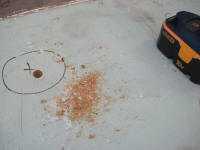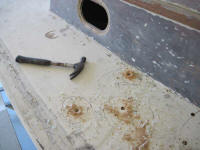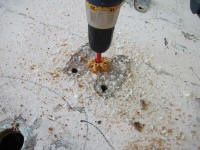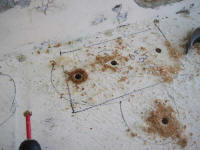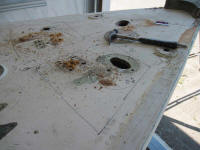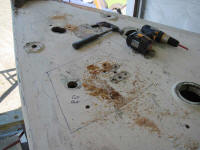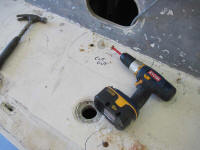
110 Cookson Lane | Whitefield, ME 04353 | 207-232-7600 | tim@lackeysailing.com
After a productive meeting at the boat with the owner on Saturday, the path forward seemed a bit more clear, though containing the overall scope of the project looked like it would continue to be a sleeping giant throughout the upcoming project.
Last week, I'd removed the paint from and sanded a portion of the decks, at least in part so that I'd have a better idea what lay beneath in time for our meeting, so I could be better informed. But I'd not yet taken the time to truly inspect the fiberglass portions of the decks--the sidedecks and foredeck--to determine the underlying condition of the balsa core. We knew that the poop deck required rebuilding/recoring, and so far my impressions of the remaining deck areas had been generally positive in that there appeared to be no signs of widespread core damage--at least to the extent I'd so far been able to determine.
So to begin the day, I sounded the deck areas with a steel hammer and noted with a marker all the areas of suspect sounding results. Most of the noted areas seemed to be simple debonding, where the top skin separates from the core beneath, and which is not necessarily--or even often--indicative of actual core problems. Debonding of the top skin from balsa core is a common and usually relatively insignificant issue often stemming from poor initial bonding techniques used during the original construction--latent defects and other areas that may have never bonded properly. The deck was riddled with minor cracking, both radial stress cracks and smaller, non-directional cracking, which was visible in the areas where I'd already sanded as well as through the layers of paint in other areas, so this condition was no surprise.
When I'd finished sounding, I used a drill to bore test holes in and around the demarked areas as required, the purpose of which was to provide a visual sense of the core and structural condition; the holes are easy to repair and offer a critical insight into the deck's condition. I drilled many holes, but show only a few representative images below.
Fortunately, nearly all the areas tested produced dry core in good condition. I did mark four larger areas where the core samples had shown damp or wet core, notably both sides of the foredeck in way of the numerous fastener and other penetrations, and one smaller area on each sidedeck, near the cabin trunk in both cases.
With this task out of the way, and a better idea of the deck's condition, I could proceed with sanding for now. I began on the coachroof, where I sanded the starboard side to remove the old paint. As before, the sheathing was generally in sound condition on the coachroof and would require only minor repair work as a matter of course.

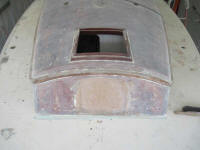
Next, I moved on to the starboard side of the cabin trunk. Visually, this side had been in somewhat worse condition than the port side, with several larger areas clearly visible where the sheathing had already peeled away from the plywood substrate. So it shouldn't have been a surprise that I found this condition to be rather widespread over much of the area once I started sanding, yet it was still a disappointment to discover.
As I sanded, I noted more and more areas where the sheathing--apparently Dynel from its appearance, though I had no confirmation--was clearly debonded from the plywood beneath, these areas demarked by a yellowish appearance that was indicative of air voids beneath.
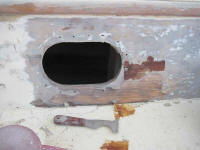
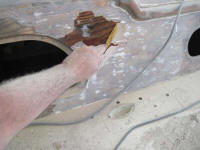
Working my way aft--I'd begun at the forward end--I eventually found an area that was clearly and obviously loose beneath the old peeling paint, and, with a putty knife, I was able to easily pull away a large section. This continued as I sanded around the deadlight openings in the main cabin, to the point where I ended up removing most of the old sheathing material to bare wood. In some instances, the plywood beneath the sheathing was damp to the touch, clearly pointing to water infiltration from the port openings as one of the culprits of the sheathing failure. Fortunately, the plywood appeared to be sound despite its dampness.

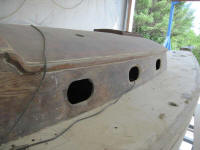
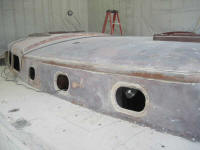
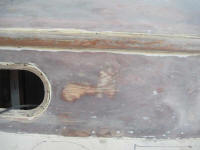
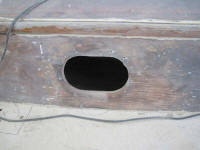
I'd located similar--yet smaller--areas on the port side last week, though at the time I'd thought perhaps minor spot repairs would take care of the problem. Revisiting the area now, however, with the new information gleaned from the starboard side, I realized that there were indications of additional debonded areas on this side as well, though they were much smaller and less significant than on the starboard side.
The ramifications of these findings were that it now looked like it'd be necessary to remove entirely the old sheathing from the cabin trunk sides and replace it. This would necessitate removal of at least portions of the existing eyebrow trim, which we'd originally been considering leaving in place barring a requirement to remove it, as the owner indicated it was relatively new and didn't leak. I could have prepped and painted around the trim in place, but now, faced with the possibility of resheathing the sides of the trunk, I didn't think it made sense to leave the trim. I reverently hoped the trim would be removable without a significant fight, and without damage, but that would depend on its original installation. In any event, there was no eyebrow on the raised doghouse portion of the cabin trunk, so at least those areas were clear.
The forced removal of the sheathing on the starboard side did begin to reveal the answers to some questions I'd had about the interior trim, however. Earlier, during my initial interior parts removal, I'd pondered how to remove some base trim from the lower edge of the interior cabin trunk side. This trim, which would have to be removed in order to replace the damaged 1/4" mahogany veneer on the inside of the trunk, wrapped beneath the sidedecks and seemed quite well adhered. On a test piece in the head, I found some screws on the underside, but removing them didn't allow the trim to budge.
Now, with the sheathing removed on the starboard side, I could clearly see a series of filled screw holes that appeared to coincide with the location of this interior trim piece. Perhaps this was the answer to its removal. Further careful surgery and removal attempts would tell the tale.
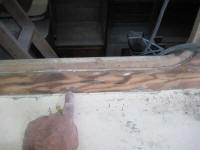
Finally, I heard from an interested reader who indicated that the plywood cabin trunk on this boat seemed to be an anomaly, since to the best of her knowledge the boats of this series, built by DeVries/Lentch in Holland, were equipped with a molded fiberglass cabin trunk. A brief research into photos of other Swiftsures online seemed to support this contention, as there were clear differences in the shape of the cabin trunk and particular in its inward appearance in some of the photos. I'd not realized this might be unusual, as I'd not been aboard a Swiftsure other than this one.
Continuing work, I removed the paint and nonskid from the remainder of the port sidedeck as far as the foredeck--slow going, as before. I excepted the area that I'd marked as requiring recore, since I'd be removing and disposing of the old skin during that process.
The chainplate slots featured recessed areas that had been filled with sealant. This was an interesting idea, but would have been more effective if the builder (or whomever had created them) had taken the time to seal the exposed core against which the sealant lay. Fortunately, at least on this side, there didn't appear to have been leakage into the core and subsequent damage.

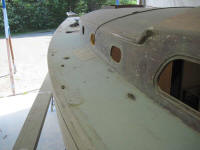
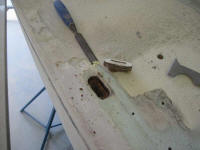
This paint removal uncovered one more item of interest. During hardware removal, I'd removed two bronze recessed fittings (purpose unknown) from the sidedecks, which removal left molded recesses in the deck that more or less exactly matched the hidden profile of the hardware. Now, as I removed paint along the cabin trunk a bit further forward, I found an identically-sized footprint in the deck, partially cut off by the cabin trunk, that had been previously filled and painted over. Curious. Did this tie in somehow with the non-standard plywood cabin trunk?
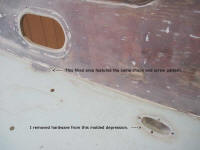
Total Time on This Job Today: 7.75 hours
